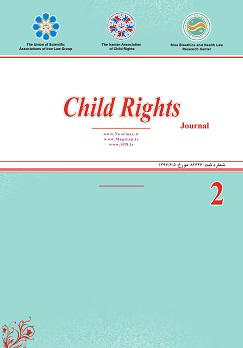Preventive Strategies towards Victimization of Labor Childeren; Activity-Based Pattern
Subject Areas : child rights
Mehdi Khaghani Esfahani
1
![]() ,
Ghasem Mohamadi
2
,
Ghasem Mohamadi
2
1 - Assistant Professor of Criminal Law and Criminology, the Organization for Researching and Composing University Textbooks in Humanities (SAMT), Tehran, Iran
2 - Assistant Professor of Criminal Law and Criminology, Shahid Beheshti University, Tehran, Iran
Keywords: Child Labor, Harmful Environment, Criminal Ecology, Urban Geometry Prone to Crime, Access to Justice,
Abstract :
Labor childeren, whether street and active in closed environments, works with customary practices (such as street peddler), semi-customary (such as garbage) and unconventional (such as prostitution). Several criminological theories, including Social Strain theory, Criminal Ecology theory and Cultural Conflict theory, have provided important cognitive explanations of the phenomenon of child labor, but other criminological theories, such as the theory of Opportunity and the theory of Everyday Activities, can be used to model the type of conventional, semi-conventional and unconventional activities of children used the offenders who often fall victim to them. Inconsistencies in the habitat, inaccuracies in the perilous environment, inability/ignorance of counseling institutions in crisis intervention, perceptual and behavioral disorders and lack of citizenship rehabilitation skills provide the opportunity to commit certain crimes against child labor in turbulent metropolitan furniture. Awareness of what kind of activities by types of child labor, the context of victimization in which crimes increases, enables intelligent child labor victimization strategies to be given to custodial policemen in the field of child protection. Adopting a prevention strategy without a specific knowledge about the status of environmental conditions harmful to children, the sustained failure of these strategies persists. This article, after applying the criminological theories on the factors and the process of child victimization, explains the meaningful relationship between the crimes committed against these children by their type of work (conventional, semi-conventional and unconventional) and strategies for increasing the crime of committing crimes against these children and enhancing immunity.
1. Azimzade F. The Phenomenon of Street Children and Strategies to Deal with it. Nedaye Sadegh 2002; 31: 101-118.
2. Moeidfar S. Sociology of Contemporary Social Issues in Iran. Tehran: Sarzamine Ma; 2000. p.302.
3. Hoseini H. Child labor and street children. Tehran: Salman, 2012. p.95.
4. Shishegaran M, Haji M. Victimological Analysis of labor Childeren. Ghanoonyar 2017; 2(8): 477-506.
5. Bahreini S, Tajbakhsh G. The concept of territory in urban design. Fine Arts Magazine of Tehran University 1999; 6: 18-31.
6. Ebrahimi S. Priventive Criminology. Tehran: Mizan; 2012. p.83.
7. Salehi E. The Role of Environmental Comfort of Urban Spaces in Preventing Behavioral Abnormalities. Ecology 2007; 33(44): 122-139.
8. Beyramei M. Relationship between parenting and educational achievement. Journal of Educational Sciences 2010; 3(10): 7-21.
9. Hedayat H, Hashemi S. The Need for Family-based Care of the Victim's Child and the Exceptions to it; A Reflection on Iran's Legal System and the Human Rights System. Criminal Law Research 2017; 19: 127-163.
10. Azad Armaki T, Bahar M. Social Issues Analysis. Tehran: Nashr Jehad; 1998. p.191.
11. United Nations Children’s Fund, UNICEF Country Office Annual Report: Iran Republic. New York: UNICEF; 2018. p.68.
12. Ezazi S. Family Sociology. Tehran: Roshangaran; 2010. p.183.
13. Jangholi M. Summarizing the Findings of the Meta-analysis of Street Children Research, Proceedings of the First National Conference on Social Harm in Iran. Tehran: Agah; 2007. Vol.5 p.229.
14. Allison J, James A. Key Concepts in Childhood Studies. London: Sage; 2012. p.201.
15. Dehganpour D. A Summary of the Findings from the Meta-analysis of Street Children Research, Proceedings of the First National Conference on Social Harm in Iran. Tehran: Agah; 2007. Vol.5 p.204.
16. Salimi A. Sociology of deviations. Qom: Hoze & Daneshgah; 2007. p.127.
17. Shahverdi T. A look at the status of street children in Iran and its factors, Proceedings of the First National Conference on Social Harm in Iran. Tehran: Agah; 2007. Vol.5 p.329.


